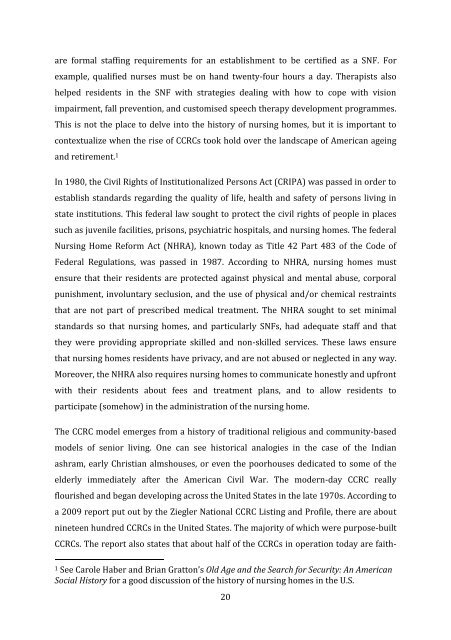Philip Y. Kao PhD thesis - Research@StAndrews:FullText
Philip Y. Kao PhD thesis - Research@StAndrews:FullText
Philip Y. Kao PhD thesis - Research@StAndrews:FullText
You also want an ePaper? Increase the reach of your titles
YUMPU automatically turns print PDFs into web optimized ePapers that Google loves.
are formal staffing requirements for an establishment to be certified as a SNF. For<br />
example, qualified nurses must be on hand twenty-four hours a day. Therapists also<br />
helped residents in the SNF with strategies dealing with how to cope with vision<br />
impairment, fall prevention, and customised speech therapy development programmes.<br />
This is not the place to delve into the history of nursing homes, but it is important to<br />
contextualize when the rise of CCRCs took hold over the landscape of American ageing<br />
and retirement. 1<br />
In 1980, the Civil Rights of Institutionalized Persons Act (CRIPA) was passed in order to<br />
establish standards regarding the quality of life, health and safety of persons living in<br />
state institutions. This federal law sought to protect the civil rights of people in places<br />
such as juvenile facilities, prisons, psychiatric hospitals, and nursing homes. The federal<br />
Nursing Home Reform Act (NHRA), known today as Title 42 Part 483 of the Code of<br />
Federal Regulations, was passed in 1987. According to NHRA, nursing homes must<br />
ensure that their residents are protected against physical and mental abuse, corporal<br />
punishment, involuntary seclusion, and the use of physical and/or chemical restraints<br />
that are not part of prescribed medical treatment. The NHRA sought to set minimal<br />
standards so that nursing homes, and particularly SNFs, had adequate staff and that<br />
they were providing appropriate skilled and non-skilled services. These laws ensure<br />
that nursing homes residents have privacy, and are not abused or neglected in any way.<br />
Moreover, the NHRA also requires nursing homes to communicate honestly and upfront<br />
with their residents about fees and treatment plans, and to allow residents to<br />
participate (somehow) in the administration of the nursing home.<br />
The CCRC model emerges from a history of traditional religious and community-based<br />
models of senior living. One can see historical analogies in the case of the Indian<br />
ashram, early Christian almshouses, or even the poorhouses dedicated to some of the<br />
elderly immediately after the American Civil War. The modern-day CCRC really<br />
flourished and began developing across the United States in the late 1970s. According to<br />
a 2009 report put out by the Ziegler National CCRC Listing and Profile, there are about<br />
nineteen hundred CCRCs in the United States. The majority of which were purpose-built<br />
CCRCs. The report also states that about half of the CCRCs in operation today are faith-<br />
1 See Carole Haber and Brian Gratton’s Old Age and the Search for Security: An American<br />
Social History for a good discussion of the history of nursing homes in the U.S.<br />
20
















